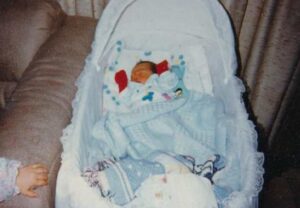
Cradle — Urnaq
Urnamen carliaq lliiluku. – Put the baby in the cradle.
Finding a safe place for a baby to rest is always a concern. In classical Alutiiq society, mothers solved this problem by using cradleboards. Babies were tightly swaddled to cradleboards, which could be laid on the floor, stood in a corner, or carried like a pack. A cradleboard collected from the village of Nuchek in Prince William Sound features a wooden frame lashed together with spruce root and covered with dehaired sealskin. Oval rings of flexible wood formed handles on either end.
Although Alutiiq people adopted different styles of cradles in the historic era, many continued to transport babies on boards. Elders recall siblings being tied to mom or dad with a shawl, or being carried on front boards, which rested against a parent’s chest. And toddlers were hoisted onto an adult’s shoulders for traveling.
When did the practice of cradle-boarding start? Studies of Alutiiq crania suggested that this practice began in the late prehistoric era. Repeated use of a cradleboard can cause a baby’s soft head to flatten and elongate, creating a distinctive shape to the head. Physical anthropologists note this elongation starting about seven hundred years, but not before. This suggests that cradleboards were part of late prehistoric Alutiiq culture.
The word urnaq refers to a different type of cradle. These wood and canvas baby beds hung from ropes from the ceiling forming a type of hammock. Parents sometimes suspended such a cradle near the foot of their own bed. This allowed a mother to swing the cradle with her foot, soothing a fussy baby at nighttime.
Listen to podcast at Alutiiq Museum website
